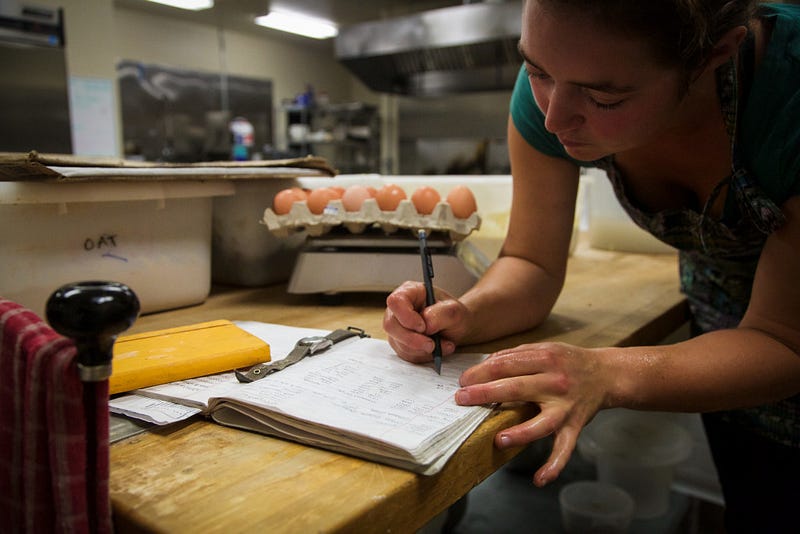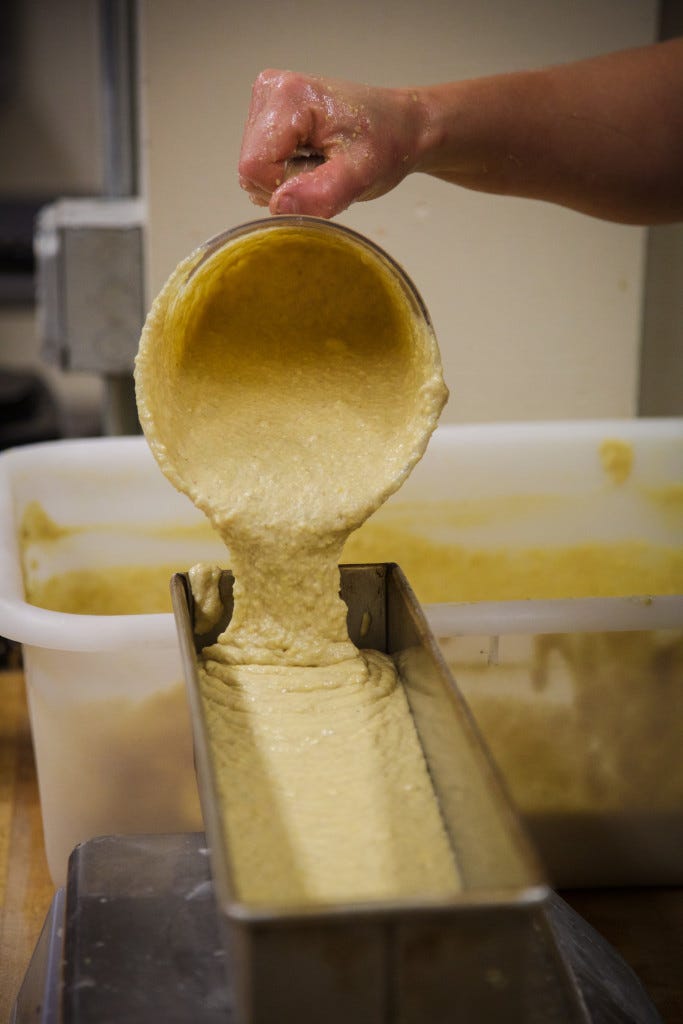Rise
The science behind creating bread
STORY BY DANIEL ROTH | PHOTOS BY DANIELLA BECCARIA
The smell hits you before they’re even finished. When they finally emerge from the oven, the loaves stand tall, deeply browned domes dusted with light tan flour. The crusty exterior feels firm and solid, though the loaf feels light for its size. The loaves crackle and pop softly as their crust settles. The bread’s tempting aroma fills the kitchen where their creator, Sophie Williams, has spent the last 10 hours working toward this moment.
Williams’ deep brown hair is pulled back into a French braid. She’s dressed more like a home baker than a professional one; dark jeans and turquoise T-shirt, a patterned apron tied around her waist. She also often wears a dimpled, rosy-cheeked smile when she talks about her affinity for baking bread.

“It’s a living creature. It’s so complicated. All of the interactions between yeast and bacteria and time and temperature, it’d really easy to take these whole-wheat flours and bake a flavorless brick. I made a lot of brick bread last year when I was figuring things out,” she says.
Williams started her one-woman baking enterprise, Raven Breads, a year and a half ago. A longtime interest in food culture led to a winter spent studying with bread bakers along the West Coast, and Raven Breads was born not long after. Since then, evidences of her passion have found their way into other parts of her life.
“I have so much flour in my phone, the buttons don’t work anymore,” she says. She used to bring her laptop into the kitchen for recipes, but had the same issue. Now she just brings a battered but neatly organized composition notebook which holds all her recipes.
Take a look at those recipes, and you might be surprised by their simplicity. The aforementioned loaves contain just three ingredients; flour, water and salt. But there’s a lot more going on behind the scenes.
In order for bread to not be a dense inedible brick, it needs yeast, which in Williams’ case comes in the form of a sourdough starter culture. To make a culture, just mix flour (preferably whole wheat) with water and wait. This provides an environment for wild yeasts and bacteria to flourish and reproduce.

In a sourdough bread, wild yeast serves the same function as commercially produced yeasts do, consuming sugars and releasing carbon dioxide, which allows the bread to rise. The bacteria consume sugars the yeasts cannot, producing lactic acid, which gives sourdough bread its tang.
This means that the yeast and bacteria work in tandem to do some of the digesting for you before you even eat the bread. Some studies have gone as far as to suggest that sourdough bread cultures can make bread products digestible for people with gluten intolerance.
Sourdough bread has its benefits, but one of the reasons it has yet to be widely adopted is how time-intensive it is; for Williams baking bread is typically a 10 to 15-hour process. Around 8 a.m., the bulk of the flour and water are mixed together and allowed to rest, then the starter culture and salt are mixed in. The dough is then largely left alone for the next four to five hours, for ‘bulk fermentation.’
Kitchen environment is crucial at this stage, especially temperature. Warmth fosters yeast activity and cold slows it. Even a five-degree difference can hugely affect rising times and fermentation, Williams says. Learning to work around a fluctuating environment is part of the job.
“As with any craft, it’s kind of a combination of art and science. It’s both gaining hand knowledge — knowing when things feel right — and also keeping very careful notes about times and temperatures and how things look, so you can go back and see what works and what doesn’t,” Williams says. “I depend more on the intuition than note-taking, because I have such an uncontrolled environment.”
Case in point; today, the commercial kitchen is warmer than usual, the yeasts are working overtime, so quick that the loaves are ready to be loaded into the oven before it’s even been adequately preheated. So to halt their progress, Williams packs the loaves into the fridge, slowing the yeast’s activity, until the oven is ready for them.

When the oven is finally ready, Williams makes cuts in the tops of the loaves, allowing them room to expand outward in the oven. With a razor blade she cuts a snaking line about an inch deep in the center of the loaves, with four small, shallow cuts on each side.
It has a moist middle, ringed by a crisp, darkly browned crust, with pleasing bitter notes. It has a light, but not overwhelming, sourness. Perhaps more than anything else, it tastes of pure, unadulterated wheat. The bread’s relatively high acid content means that it has a long shelf life, but after tasting it, it’s hard to imagine how anyone could keep it around for long.
